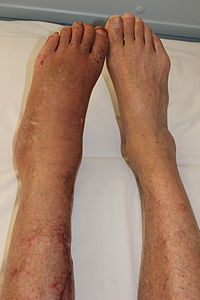
Photo from wikipedia
OBJECTIVE Somatic Symptom Disorder (SSD) is a reflection of medically unexplained physical symptoms that lead to distress and impairment in social and occupational functioning. SSD is phenomenologically diagnosed and its… Click to show full abstract
OBJECTIVE Somatic Symptom Disorder (SSD) is a reflection of medically unexplained physical symptoms that lead to distress and impairment in social and occupational functioning. SSD is phenomenologically diagnosed and its neurobiology remains unsolved. APPROACH In this study, we performed hyper-parameter optimized classification to distinguish 19 persistent SSD patients and 21 healthy controls by utilizing Functional Near Infrared Spectroscopy via performing two painful stimulation experiments, Individual Pain Threshold (IND) and Constant Sub-Threshold (SUB), that include conditions with different levels of pain (INDc & SUBc) and brush stimulation. We estimated dynamic functional connectivity time series by using sliding window correlation method and extracted features from these time series for these conditions and different cortical regions. MAIN RESULTS Our results showed that we found highest specificity (85%) with highest accuracy (82%) and 81% sensitivity using SVM classifier by utilizing connections between Right Superior Temporal- Left Angular Gyri, Right Middle Frontal (MFG) - Left Supramarginal Gyri and Right Middle Temporal - Left Middle Frontal Gyri from INDc condition. SIGNIFICANCE Our results suggest that fNIRS may distinguish subjects with SSD from healthy controls by applying pain in levels of individual pain-threshold and bilateral MFG, left Inferior Parietal and Right Temporal Gyrus might be robust biomarkers to be considered for SSD neurobiology.
Journal Title: Journal of neural engineering
Year Published: 2019
Link to full text (if available)
Share on Social Media: Sign Up to like & get
recommendations!